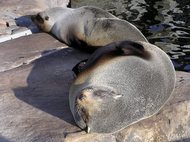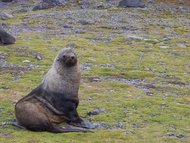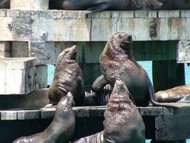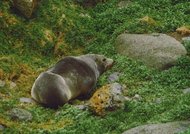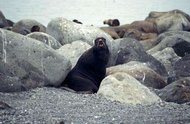Fur seals
Fur seals are nine species of marine mammals on the family of eared seals.
Contents
Physical Appearance
Fur seals differ from the true seals in having small external earflaps and hind flippers that can be turned to face forwards. Together with strong front flippers, this gives them extra mobility on land and an adult fur seal can move extremely fast across the beach if it has to. They also use their front flippers for swimming, whereas true seals use their hind flippers.
|
Scientific Classification Kingdom: Anamalia (Animals) |
Like other Eared seals, the malesareconsiderably larger than the female, in some instances, up to five times as large. This makes them among the most sexually dimorphous mammals.
Fur seals differ from sea lionsin that theyhave adense underfur whereas sea lions have a coarse, short fur . Sea lions are also generallylarger thanfur seals.
Species
Fur seals are grouped into two genera:
- Arctocephalus (Southern fur seals)1. South American fur seal (Arctocephalusaustralis)2. New Zealand fur seal (also Antipodean fur seal, Australasian fur seal, Black fur seal, and South Australian fur seal.) (Arctocephalusforsteri)3. Galapagos fur seal (Arctocephalusgalapagoensis)4. Antarctic fur seal (also Kerguelen fur seal) (Arctocephalusgazella) 5. Juan Fernandez fur seal (Arctocephalusphilippii)6. South African fur seal (also Cape fur seal, Australian fur seal, Brown fur seal, Giant fur seal, Tasmanian fur seal, and Afro-Australian Fur Seal) (Arctocephaluspusillus)7. Guadalupe fur seal (Also Lower californian fur seal) (Arctocephalustownsendi)8. Subantarctic fur seal (also Amsterdam fur seal) (Arctocephalustropicalis)
- Callorhinus (Northern fur seal) 9. Pribilof fur seal (also Northern fur seal and Alaska fur seal) (Callorhinus ursinus)
Fur seals are closed related to sea lions, with whom theycomprise the family of Eared Seals (scientific name: Otariidae). Together with the families of true seals and Walruses, Eared seals form the group of marine mammals known as Pinnipeds.
Reproduction
Fur seals are polygynous, meaning that males will establish territories (often created and protected through fighting or shows of aggression) within which they establish a harem and breed witha number of females (the range varies with species). Males will come ashore and establish their territories at the beginning of the mating season.
Females typically arrive a few weeks after the males and select their mates for the coming season. Before mating, the females will first give birth to a pup conceived during the mating season of the prior year. Mating occurs typically 6-12 days after the birth of the pup.
The fertilised egg within the female fur seal undergoes a three - four month period of delayed implantation. This ensures that that the developing pup will be born at the right time the following year when the animals return to their breeding grounds.
Females will nurse their young for anything from seven months to three years.
Distribution
Fur seals are primarily found in the southern hemisphere.Twospecies, the Pribilof fur seal and Guadalupe fur seal,are found in the northern hemisphere,and a third, the Galapagos fur seal, is found on the equator.
|
Coast of South America from southern Peru to Southern Brazil, Falkland Islands, South Georgia | |
| South Island, New Zealand, the Bounty Islands,the coast of southwestern Australia | |
| Galapagos Islands | |
|
Seasonally ice-free islands south of the convergence in theSouthern Ocean | |
|
Juan Fernandez Islands off the coast of Chile | |
|
Coast of Namibia and western/southern South Africa, southwest coast of Australia | |
|
Isla de Guadalupe, off the coast of Baja California, Mexico (breeding, non-breeding observed farther south and north) | |
|
Islands just north of the convergence/Southern Ocean | |
|
Northern Pacific Ocean withmain breeding groundson the Pribilof Islandsin Bering Sea |
Conservation Status
Fur seals were heavily hunted up to the end of the nineteenth century, at which point many of the species were close (and in some cases thought be) extinct. As their name suggests, their primary value was for their skins and the thick underfur. They were also exploited for their oil andmeat. Most of these species have, under legal protection, made a significant recovery. At this time, only the Galapagos fur sealis considered endangered.
| Least Concern | |
| Least Concern | |
| Endangered | |
| Least Concern | |
| Near Threatened | |
| Least Concern | |
| Near Threatened | |
| Least Concern | |
| Vulnerable |
Further Reading
- Arctocephalus, Encyclopedia of Life (accessed April 5, 2009)
- Arctocephalus,Myers, P., R. Espinosa, C. S. Parr, T. Jones, G. S. Hammond, and T. A. Dewey, 2008, Animal Diversity Web (accessed April 5, 2009)
- Seal Conservation Society (accessed April 5, 2009)
- The Pinnipeds: Seals, Sea Lions, and Walruses, Marianne Riedman, University of California Press, 1991 ISBN: 0520064984
- Encyclopedia of Marine Mammals, Bernd Wursig, Academic Press, 2002 ISBN: 0125513402
- Marine Mammal Research: Conservation beyond Crisis, edited by John E. Reynolds III, William F. Perrin, Randall R. Reeves, Suzanne Montgomery and Timothy J. Ragen, Johns Hopkins University Press, 2005 ISBN: 0801882559
- Walker's Mammals of the World, Ronald M. Nowak, Johns Hopkins University Press, 1999 ISBN: 0801857899
- Arctocephalus, MarineBio.org (accessed April 5, 2009)
